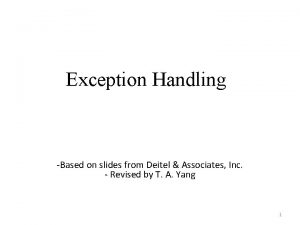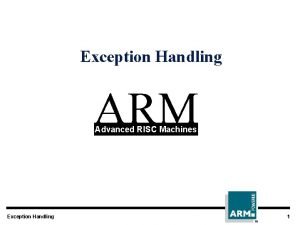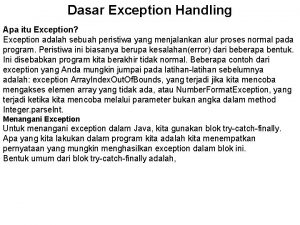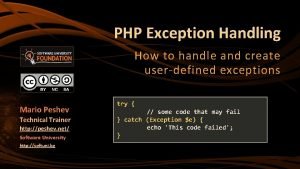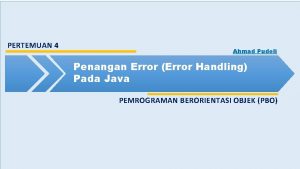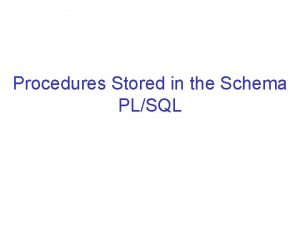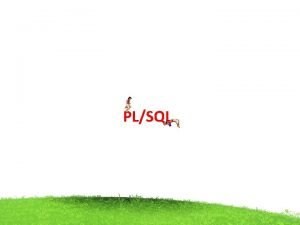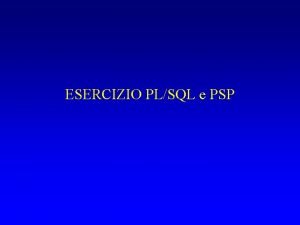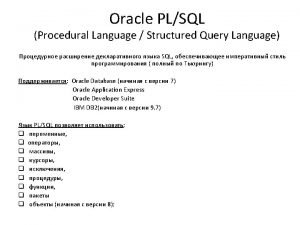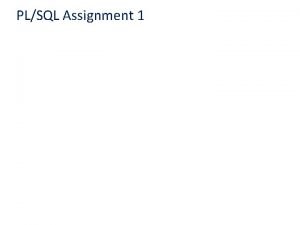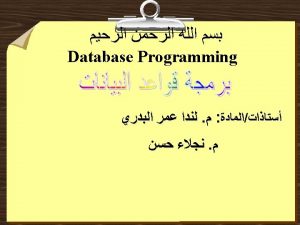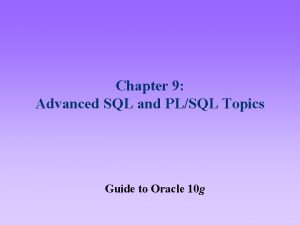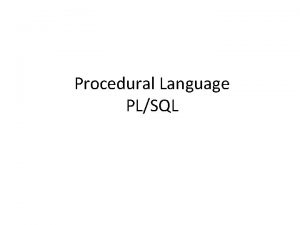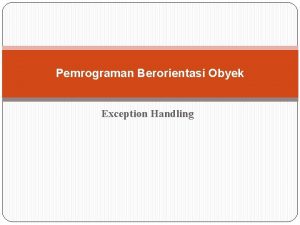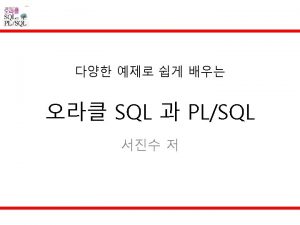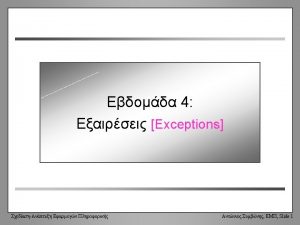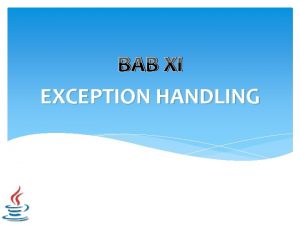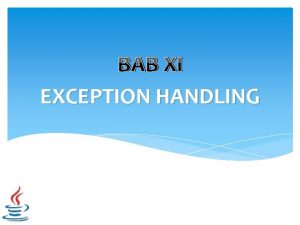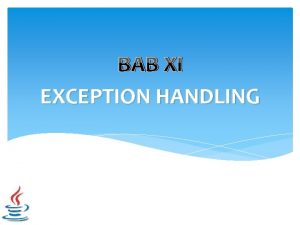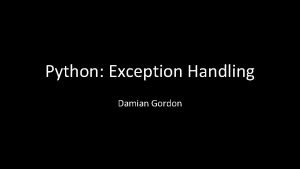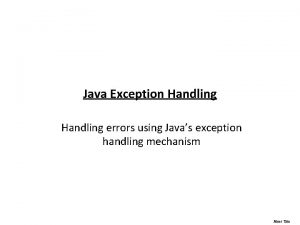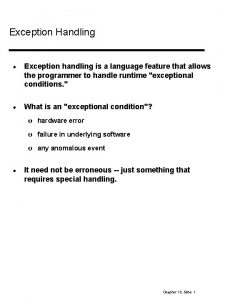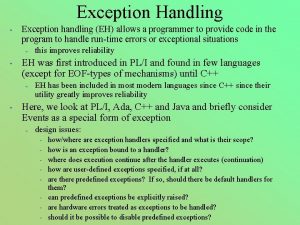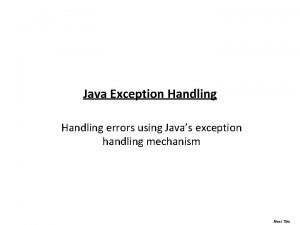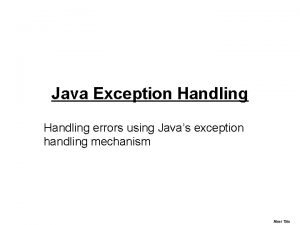Exception Handling in PLSQL POINTS TO DISCUSS What






















- Slides: 22

Exception Handling in PL/SQL

POINTS TO DISCUSS • What is Exception Handling • Structure of Exception Handling Section • Types of Exceptions

What is Exception Handling • • Error condition in PL/SQL is called exception. A part of Executable section Between Begin… and end; Using Exception Handling we can test the code and avoid it from exiting abruptly. • When an exception occurs a message which explains its cause is received.

Exception consists of 3 parts • Type of Exception • An Error Code • A message By handling exceptions we ensure a PL/SQL block does not exit abruptly.

Syntax for exception DECLARE Exception Declaration BEGIN Executable statements… EXCEPTION WHEN ex_name 1 THEN -Error handling statements WHEN ex_name 2 THEN -Error handling statements WHEN Others THEN -Error handling statements END; When an exception is raised, Oracle searches for an appropriate exception handler in the exception section. Only one exception can be raised in a Block and the control does not return to the Execution Section after the error is handled.

Types of Exceptions • Pre defined Exceptions • Unnamed System Exceptions • User-defined Exceptions

Named System Exceptions (Predefined) • Automatically raised by Oracle when a program violates a RDBMS rule • System exceptions that are raised frequently are predefined and given a name in Oracle • Not Declared explicitly • Raised implicitly when a predefined Oracle error occurs • Caught by referencing the standard name within an exception-handling routine

Some Named (Predefined) Exceptions Exception Name Reason Error Number CURSOR_ALREADY_OPEN When you open a cursor that is already ORA-06511 open. INVALID_CURSOR When you perform an invalid operation ORA-01001 on a cursor like closing a cursor, fetch data from a cursor that is not opened. NO_DATA_FOUND When a SELECT. . . INTO clause does not return any row from a table. TOO_MANY_ROWS When you SELECT or fetch more than ORA-01422 one row into a record or variable. ZERO_DIVIDE When you attempt to divide a number by. ORA-01476 zero. ORA-01403

Predefined Exception Example declare v_empno empno%type; v_ename emp. ename%type; v_sal emp. sal%type; a number; begin a: =&a; select empno, ename, sal into v_empno, v_ename, v_sal from emp where empno=&v_empno; v_sal: =v_sal+v_sal/a; dbms_output. put_line('Employee number is '||v_empno || ' and name is '||v_ename); dbms_output. put_line('New salary is '||v_sal); exception when no_data_found then dbms_output. put_line('NO SUCH RECORD!!!'); when zero_divide then dbms_output. put_line('Salary cannot be divided by zero'); when others then dbms_output. put_line('Some error. GOD knows what? ? ? '); end; /

Unnamed System Exceptions • System exception for which oracle does not provide a name is known as unnamed system exception. • These exceptions do not occur frequently. • These Exceptions have a code and an associated message. • There are two ways to handle unnamed system exceptions: 1. By using the WHEN OTHERS exception handler, or 2. By associating the exception code to a name and using it as a named exception.

Unnamed exceptions • We can assign a name to unnamed system exceptions using Pragma EXCEPTION_INIT. • EXCEPTION_INIT will associate a predefined Oracle error number to a programmer_defined exception name.

Syntax for unnamed system exception using EXCEPTION_INIT DECLARE exception_name EXCEPTION; PRAGMA EXCEPTION_INIT (exception_name, Err_code); BEGIN Execution section EXCEPTION WHEN exception_name THEN handle the exception END;

Example DECLARE dup_pr_key exception; pragma exception_init(dup_pr_key, -1); BEGIN insert into emp(empno, ename) values(1111, 'ABCD'); dbms_output. put_line('One record successfully inserted'); insert into emp(empno, ename) values(1111, 'EFGH'); dbms_output. put_line('One more record successfully inserted'); EXCEPTION when dup_pr_key then dbms_output. put_line('How come more employees with the same employee number !!!'); END; /

User-defined Exceptions • They should be explicitly declared in the declaration section. • They should be explicitly raised in the Execution Section. • They should be handled by referencing the userdefined exception name in the exception section.

User defined Exception-Example declare v_empno empno%type; v_ename emp. ename%type; v_sal emp. sal%type; a number; lo_sal exception; begin a: =&a; select empno, ename, sal into v_empno, v_ename, v_sal from emp where empno=&v_empno; v_sal: =v_sal+v_sal/a; if v_Sal<2000 then raise lo_sal; end if; dbms_output. put_line('Employee number is '||v_empno || ' and name is '||v_ename); dbms_output. put_line('New salary is '||v_sal); exception when lo_sal then dbms_output. put_line('In these times of Inflation INCREASE THE SALARY !!!'); when others then dbms_output. put_line('Some error. GOD knows what? ? ? '); end;

RAISE_APPLICATION_ERROR ( ) • a built-in procedure in oracle used to display the user-defined error messages along with the error number • range of error number between -20000 and 20999. • Whenever a message is displayed using RAISE_APPLICATION_ERROR, all previous transactions which are not committed within the PL/SQL Block are rolled back automatically (i. e. change due to INSERT, UPDATE, or DELETE statements). • raises an exception but does not handle it.

WHY RAISE_APPLICATION_ERROR ? • to create a unique id for an user-defined exception. • to make the user-defined exception look like an Oracle error.

Syntax RAISE_APPLICATION_ERROR (error_number, error_message); • The Error number must be between -20000 and -20999 • The Error message is the message you want to display when the error occurs.

Steps for RAISE_APPLICATION_ERROR procedure: • Declare a user-defined exception in the declaration section. • Raise the user-defined exception based on a specific business rule in the execution section. • Finally, catch the exception and link the exception to a user-defined error number in RAISE_APPLICATION_ERROR.

RAISE_APPLICATION_ERROR -Example DECLARE v_empno empno%type; v_ename emp. ename%type; v_sal emp. sal%type; a number; lo_sal exception; BEGIN a: =&a; select empno, ename, sal into v_empno, v_ename, v_sal from emp where empno=&v_empno; v_sal: =v_sal+v_sal/a; if v_Sal<2000 then raise lo_sal; end if; dbms_output. put_line('Employee number is '||v_empno || ' and name is '||v_ename); dbms_output. put_line('New salary is '||v_sal);

RAISE_APPLICATION_ERROR – Example(contd. ) EXCEPTION when lo_sal then RAISE_APPLICATION_ERROR(-20001, 'In these times of Inflation INCREASE THE SALARY !!!'); when others then dbms_output. put_line('Some error. GOD knows what? ? ? '); END;

THANKS
 Exception handling in java
Exception handling in java Fiq irq
Fiq irq Exception handling pada java
Exception handling pada java Event handling in ada
Event handling in ada Contoh error handling
Contoh error handling Php exceptions
Php exceptions Php exception handling
Php exception handling Error handling in vb
Error handling in vb Exception handling pada java
Exception handling pada java Exception handling in vb net
Exception handling in vb net Stored procedure plsql
Stored procedure plsql Plsql cursors
Plsql cursors Difference between oracle and pl sql
Difference between oracle and pl sql Create table in procedure oracle
Create table in procedure oracle Record type in plsql
Record type in plsql Cursores plsql
Cursores plsql Deklarasi variabel
Deklarasi variabel Plsql replace
Plsql replace Plsql programming
Plsql programming Plsql topics
Plsql topics Plsql is
Plsql is Amateurs discuss tactics professionals discuss logistics
Amateurs discuss tactics professionals discuss logistics Brand frame of reference
Brand frame of reference
